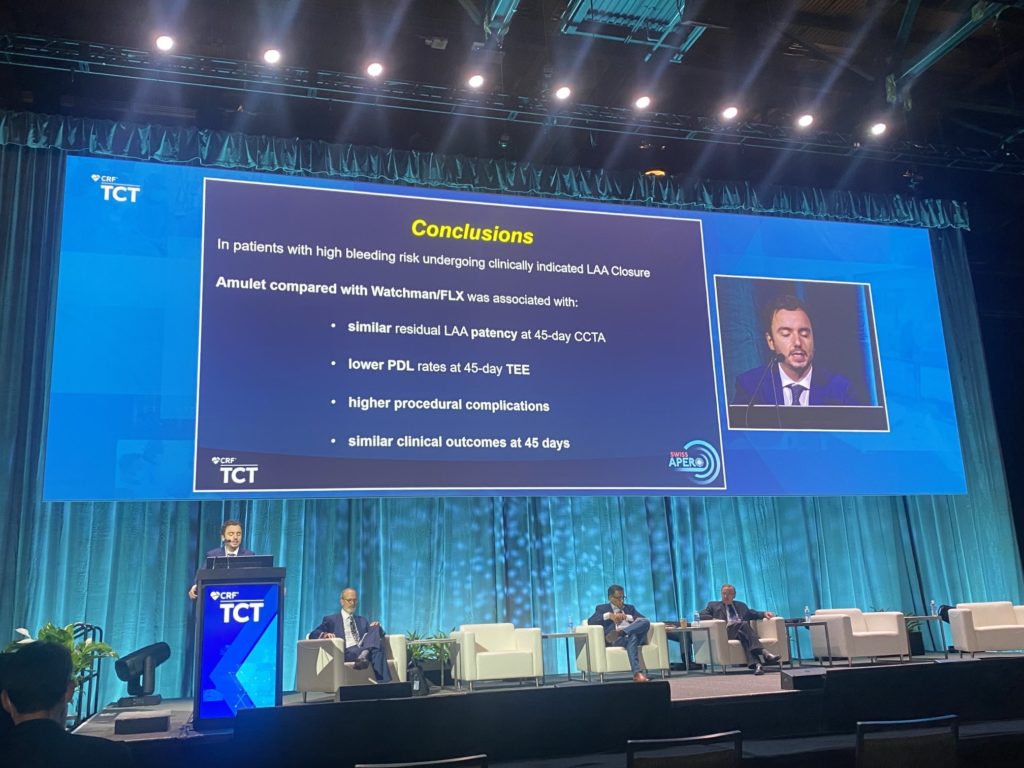
Findings of the SWISS-APERO trial, presented at the Transcatheter Cardiovascular Therapeutics annual meeting (TCT 2021, 4–6 November, Orlando USA and virtual), comparing the Amulet (Abbott) and Watchman FLX (Boston Scientific) left atrial appendage closure (LAAC) devices, show similar rates of LAA patency and clinical outcomes between the two devices.
However the investigator-initiated study, which was also published in the journal Circulation, showed differences between in terms of rates of peri-device leak at 45-day transesohageal echocardiography, favouring Amulet, but a higher rate of procedural complications compared with Watchman.
LAA closures aims at complete LAA sealing, excluding the main source of cardiac thrombi from circulation, study author Roberto Galea (Bern University Hospital, Bern, Switzerland). Amulet and Watchman are the two most commonly used LAAC devices currently in use.
Residual LAA patency after LAAC is routinely assessed after intervention by means of transesophageal echocardiography (TEE) or computed tomography (CT) as it has the potential to undermine LAAC therapeutic principle, Galea told TCT attendees. SWISS-APERO is the first randomised trial to compare Amulet and the new-generation Watchman FLX device in terms of residual patency as evaluated by 45-day CT.
In the trial, patients at eight European centres undergoing LAAC were randomised 1:1 to receive the Amulet or Watchman 2.5 or FLX. SWISS-APERO’s primary endpoint was the composite of justified crossover to a non-randomised device during LAAC procedure or residual LAA patency detected by cardiac computed tomography angiography (CCTA) at 45 days. The secondary endpoints included procedural complications, device related thrombus (DRT), peri-device leak at TEE and clinical outcomes at 45 days.
Galea told TCT attendees that between June 2018 and May 2021, 221 patients were randomly assigned to Amulet (111 [50.2%]) or Watchman (110 [49.8%]), of whom 25 (22.7%) patients included before October 2019 received Watchman 2.5, and 85 (77.3%) patients received Watchman FLX. Ascertainment of the primary endpoint was completed in 205 (92.8%) patients.
The primary endpoint occurred in 71 (67.6%) patients with Amulet and 70 (70.0%) patients with Watchman (risk ratio [RR] 0.97 [95% CI 0.80‒1.16]; p=0.713). A single justified cross-over occurred in an Amulet patient who fulfilled LAA patency criteria at 45-day CCTA. Major procedure related complications occurred more frequently in the Amulet group (9 % vs. 2.7%; p=0.047), owing to more frequent bleeding (7.2% vs.1.8%).
At 45 days, the rate of peri-device leak at TEE was higher with Watchman than Amulet (27.5% vs. 13.7%, p=0.020), albeit none was major (i.e. >5mm), whereas device-related thrombus was detected in one (0.9%) patient with Amulet and three (3%) patients with Watchman at CCTA and in two (2.1%) and five (5.5%) patients at TEE, respectively. Clinical outcomes at 45 days did not differ between the groups, Galea reported.
In his concluding remarks, Galea told the TCT audience: “In patients with high bleeding risk undergoing clinically-indicated LAAC Amulet as compared with Watchman FLX was associated with similar residual LAA patency at 45-day CT, lower peri-device leak rates at 45-day TEE, higher procedural complications, but similar clinical outcomes at 45 days.”
Cardiac electrophysiologist Mintu Turakhia (Stanford Medicine, Stanford, USA) offered an analysis of the findings during a press conference preceding the presentation of the study at TCT. Turakhia commented that study builds upon the findings of the Amulet IDE trial, which showed that Amulet was superior for the primary endpoint of LAA closure and non-inferior for the primary endpoints of safety and effectiveness versus the Watchman.
“There are a couple of interesting issues here,” Turakhia commented. “One is [that] in terms of the design of the study the achievement of the primary endpoint for the watchman device was expected to be significantly lower, while most of these absolute risk differences are not big, numerically some of these clinical outcomes—such as any bleeding—do track with the Amulet IDE study, though they may not have been powered for some of the safety events.
“I want to underscore that I think this does really highlight that…it is really important to look at these safety issues and show that they do track with the IDE study. Finally, we do not still have a proper randomised trial against the alternative therapy which is a direct oral anticoagulant for any of these. When you look at these safety events and death, it is something that you need to consider if that would happen in patients with a direct oral anticoagulant, because the eligibility nowadays is not a hard contraindication to oral anticoagulation.”












